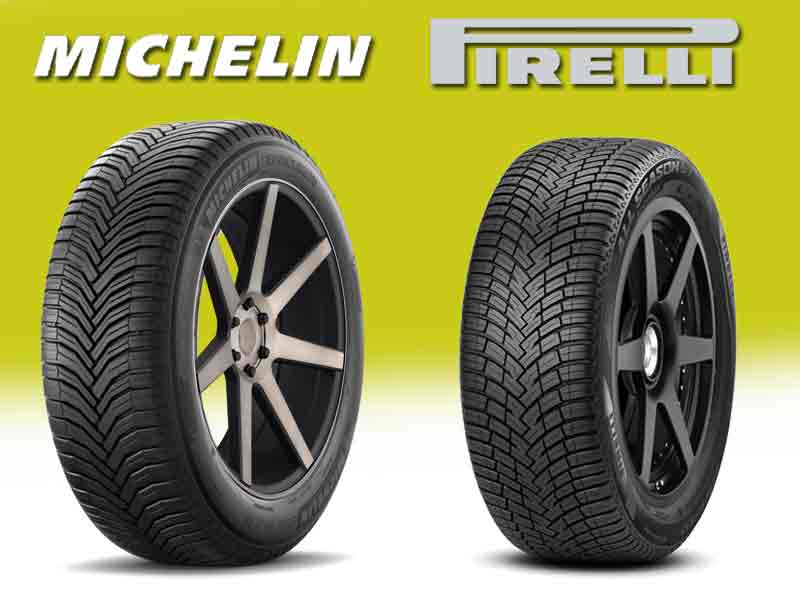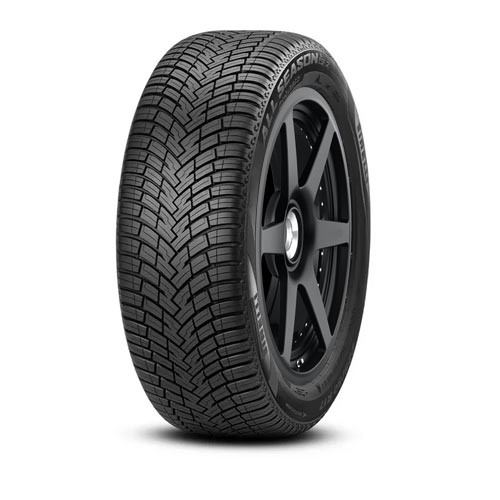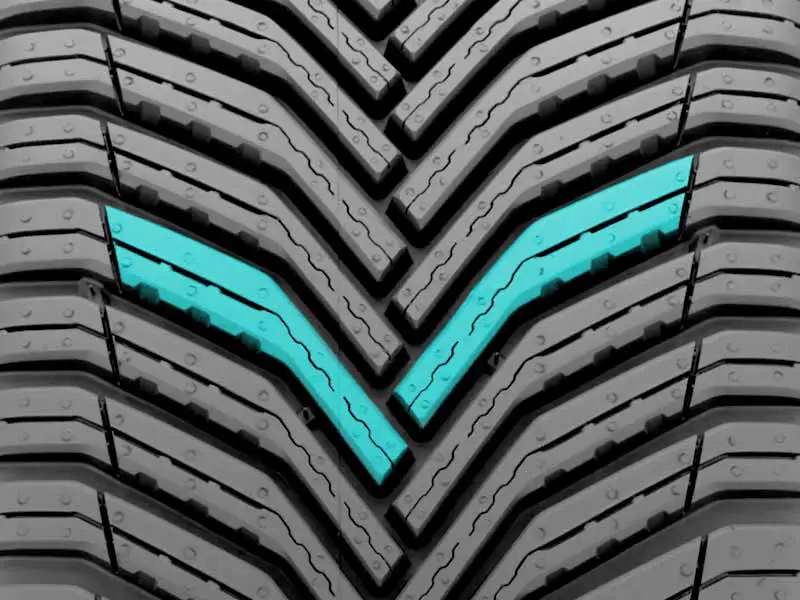The Pirelli Cinturato All Season SF2 and the Crossclimate 2 are two notable contenders in the all-season tire segment. Both models have been praised for their reliable year-round performance, so we’re here to scrutinize their individual strengths and areas for growth. Let’s get into the details.
Table of Contents
Test Scores – Out of 10
| Pirelli Cinturato SF2 | Crossclimate 2 | |
| Dry Traction | 8 | 8 |
| Wet Traction | 8 (Better) | 7 |
| Snow Traction | 8 | 9 (Better) |
| Ice Traction | 7 | 9 (Better) |
| Fuel Efficiency | 8 | 8 |
| Tread Life | 7 | 8 |
| Ride Comfort | 8 (Better) | 7 |
Michelin CrossClimate 2: Improvements could be made in ride noise, handling, and on-road vibrations due to its material makeup, central block interlocking, and harder compound.

Pirelli Cinturato All Season SF2: Enhancements could be made in directional grip, as its central blocks fail to establish a firm connection with the road, leading to longer braking distances.
Design Comparison
Starting with the Pirelli Cinturato All Season SF2.

This tire although features a directional tread pattern, just like its counterpart, it also contains 6 longitudinal ribs on it as well.
The middle ribs have blocks with a very interlocking zigzag pattern, where they form a interconnected web of tough passing grooves.
These also join up with the in-groove notches these lugs have.
The shoulders and surrounding lugs, (from these central most 2 ribs), are even more voided up, where elongated lugs are seen.
These combined allow for amazing soft snow traction, as well as resistance to hydroplaning.
Though speaking of which, the tire can use a little more siping.
Moving towards the Michelin Crossclimate 2.

So this tire features a tread pattern that excellently combines functionality and design.
Its long, interconnecting arms offer superior dry traction, while the interlocking sipes in the middle allow for efficient water expulsion.
The tread pattern also features unique lugs that trap snow, resulting in improved snow-to-snow contact and earning it a 3-peak mountain snowflake rating. (This feature is actually done better on this tire, in comparison).
Furthermore, with wider valleys between the shoulder blocks embedded with lateral slits, the tire delivers dependable grip, regardless of the road conditions.
Ride Noise
So what’s the main source of noise? Well, in a word, air.
Air particles interacting with the tire’s tread basically produce in-groove resoannce, which we call tread noise, and that air mostly seeps in through the sides/shoulders (of the tread) and bounces off the interior walls.
That’s why in this regard, the Pirelli does better.
Even though both tires have noticeable side gaps, the CrossClimate 2’s gaps are slightly larger, allowing more air to pass through. Its softer material makeup also tends to deflect air particles, creating a more pronounced resonance within the tire grooves.
Despite this, the noise difference between the two is not a lot, thanks to the Crossclimate’s rounded footprint and streamlined blocks that enable the majority of the air to exit without crashing into the walls, in the first place.
But still, overall, the tire is still louder.
Wet Traction
The efficiency of a tire’s grip on wet surfaces depends largely on two factors.
- The number of sipes.
- And the tire rubber’s composition.
Sipes work by soaking up water particles in their slits, and since they need flexibility to do that, the overall water suction abilities also get to depend on the tread’s compound too.
Now both tires offer pretty great overall traction. Though digging deeper, it was seen (on tests), that the Michelin CrossClimate 2 offered superior directional grip, while the Pirelli offered better overall wet handling, and resistance to hydroplaning,
The Crossclimate 2 with its rounded contact patch and interlocking central siping, gets to offers superior stopping efficacy.
(Interlocking sipes basically have a more powerful water suction abilities).
On the other side with more biters on the shoulders provides Cinturato All Season SF2 with better handling abilities.
Moreover, its more voided up structure also facilitates faster water evacuation through grooves, allowing the tire to have faster float speeds on both straight and curved aqua tests.
Winter Performance
The CrossClimate 2 shows noticeable improvement in winter traction performance, over its predecessor. In fact its one of the best, comparing all other premium all season options out there.
So it’s superior performance comapred to Pirelli SF2 isn’t a surprise either.
But why is this tire so great?
Well, beacuse of two things. One it offers better “snow-to-snow contact” with the ground, which is crucial as snow sticks better to snow than rubber.
And second, it’s swooping arms are more effective in shoveling snow. So they paddle snow backwards with better efficacy, generating forward momentum.
So even though both tires are branded with 3 peak mountain snowflake ratings, the CrossClimate 2 still steals the show here.
Dry Grip And Handling
The Michelin CrossClimate 2 excels in dry (directional) grip, thanks to its improved footprint, from the middle.
During tests, it surpassed the Pirelli Cinturato All Season SF2 showing noticeably shorter braking distances (a direct measure of directional grip).
Basically the Cinturato’s central blocks don’t interlock and fail to establish as firm of the overall connection with the road, as seen on its counterpart.
Though the tire does better in handling, where it’s stiffer rubber provide a much more smoother weight transition from the center to the sides.
This basically provides the tire with a more direct steering and quicker steering feedback.
On-Road Vibrations
The ability of a tire to control vibrations is directly linked to how well it can handle road bumps, and that is largely dependent on the tire’s internal and external materials.
So tires made of a softer compound, as expected, typically offer a smoother ride, with the Pirelli Cinturato All Season SF2 being a prime example.
Cinturato SF2 basically offers a very thermally adaptive softer rubber top, which not only provides superb snow traction, but also soaks up the bumps and roughness of the road, in a better way.
In contrast, despite a soft inner liner, the Crossclimate 2 with its harder compound gets to lack slightly. Though its all subjective.
To Sum Up
The Michelin Crossclimate 2 excels in:
- Directional Grip: With an improved footprint from the middle, it surpasses competitors in dry grip, as reflected by shorter braking distances.
- Winter Performance: The tire offers superior “snow-to-snow contact” and effectively shovels snow with its swooping arms, outperforming other premium all-season tires.
- Ride Noise: Despite a louder noise profile due to larger side gaps and softer material makeup, its rounded footprint and streamlined blocks facilitate air exit, making the noise difference marginal.
Pirelli Cinturato All Season SF2 excels in:
- Handling: The tire’s stiffer rubber provides a smoother weight transition from the center to the sides, allowing more direct steering and quicker feedback.
- Wet Traction: Despite not offering the best directional grip, the tire’s biters on the shoulders and more voided structure allow better handling and faster water evacuation, respectively.
- On-Road Vibrations: The thermally adaptive softer rubber top offers excellent snow traction and effectively absorbs the bumps and roughness of the road. Though it also compromises the tire’s overall tread life.